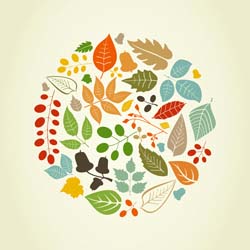Fall Planting: 8 Sages for Fragrance by Your Front Door

Colorful plantings make entryways attractive. Even better are pretty plantings that are fragrant and provide a sensory lift before you journey indoors.
Many kinds of pleasingly aromatic sages (Salvia spp.) are decorative for walkway edging, porch-side gardens, raised beds and accent plantings. Some appeal to all of the basic senses — taste, touch, smell, sight and hearing — that give dimension to our lives. They attract the buzz of birds and insect wildlife while also providing flavor, texture, perfume, color, and shape.
But there is something particularly powerful about fragrance. Scent wakes up memories and makes us see in a different way. Fragrant plants are powerful tools in therapy and sensory gardens, especially ones created for Alzheimer's patients and the blind.
Entryway Therapy
The warm scent of sages can remind you of holiday gatherings, long-forgotten outdoor hikes and favorite perfumes. The licorice-like fragrance of some sages, such as the Salvia guaranitica group, can bring back childhood visits to the candy store.
On your way to the front door, you can take a detour from worries by pausing to rub the smooth, bumpy or fuzzy leaves of a sage and inhale the fragrance from your fingertips. Call it entryway therapy.
Here are eight sensible suggestions for adding lovely scents to your landscape. We've organized them by height. The shortest sages are ideal for path edging, containers or raised beds. The tallest are excellent accent plants — you don't need to mass them for impact.
Short
Tangerine Pineapple Sage (Salvia elegans 'Tangerine') Zones 9 to 11
- Bright red flowers bloom spring to fall
- 18 inches tall and wide
- Fragrant foliage with deep green, heart-shaped leaves
- Partial shade to full sun
- Attracts honeybees and hummingbirds
The flowers of this citrusy-fragrant sage are used in teas and baked goods. Give it average watering based on local conditions.
Greek Sage (Salvia fruticosa) Zones 8 to 9
- Pink-to-lavender flowers bloom spring to fall
- 24 to 36 inches tall and 18 inches wide
- Fragrant mid-green foliage smells lavender-like
- Full sun
- Heat and drought tolerant
- Attracts butterflies, honeybees and hummingbirds
This is the main kind of culinary sage used in cooking Thanksgiving turkey. This is an extremely drought-tolerant plant that doesn't tolerate overwatering.
Mid-Sized
Buchanan's Sage (Salvia buchananii) Zones 9 to 11
- Magenta flowers bloom spring and summer
- 36 to 48 inches tall, 36 inches wide
- Fragrant, glossy, purplish-green foliage
- Partial shade
- Heat tolerant and somewhat drought tolerant
- Attracts hummingbirds
This perennial sage tolerates full sun as well as dry gardens, but does much better when it receives morning sun and afternoon shade as well as average watering based on local conditions.
Starlight Sage (Salvia x 'Starlight') Zones 8 to 11
- White flowers bloom spring to summer
- 48 inches tall and wide
- Fragrant, silvery white-green foliage
- Full sun
- Heat and drought tolerant
- Attracts honeybees
Starlight Sage combines some of the best qualities of the two most fragrant and drought-tolerant sages we grow -- White Sage (Salvia apiana) and Black Sage (Salvia mellifera).
Hummingbird Sage or Pitcher Sage (Salvia spathacea) Zones 8 to 11
- Rose red flowers bloom winter to spring
- 24 to 42 inches tall, 24 inches wide
- Sticky, basal foliage and large, reddish-green bracts
- Full sun to full shade
- Heat and drought tolerant
- Attracts hummingbirds
Hummingbird Sage is easy to grow and eye catching. It develops into a mound that spreads gently with underground runners.
Tall
Elk Argentina Skies Anise-Scented Sage (Salvia guaranitica 'Elk Argentina Skies') Zones 6 to 10
- Pale sky-blue flowers bloom summer to fall
- 72 to 84 inches tall, 36 inches wide
- Dark green foliage and bright green calyxes
- Full sun to partial shade
- Water loving
- Attracts butterflies and hummingbirds
For those unfamiliar with the fragrance of Anise, it is a heady licorice-like aroma. This is an ideal solution for damp locations. In dry areas, remember to water regularly.
Somalian Mountain Sage (Salvia somalensis) Zones 8 to 11
- Powder-blue flowers bloom summer to fall
- 48 to 60 inches tall, 36 inches wide
- Fragrant, fuzzy, lime-green foliage
- Full sun to partial shade
- Somewhat drought resistant
Although this sage does well in dry gardens, it grows best when it receives average watering based on local conditions.
Celestial Blue Sage (Salvia x 'Celestial Blue') Zones 7 to 11
- Royal blue flowers bloom in summer
- 60 inches tall and wide
- Fragrant, gray-green foliage and purple bracts
- Full sun
- Heat and drought tolerant
- Attracts butterflies, honeybees and hummingbirds
Given the dramatic blue of its flowers and its potential to grow tall and wide, this tough sage makes an excellent screen for a low front porch or patio.
Sharing Information and Thoughts on Fragrance
At Flowers by the Sea, we love helpful information and good deals. You can sign up on our homepage for free FBTS newsletters alerting you to specials and product updates. And, if you have any questions about our plants — or want to call attention to a favorite fragrant sage — please write or give us a call.
We may be out in the garden enjoying all the good smells, but our phones ring everywhere.

 Salvia fruticosa
Salvia fruticosa  Salvia buchananii
Salvia buchananii  Salvia x 'Celestial Blue'
Salvia x 'Celestial Blue'  Salvia somalensis
Salvia somalensis  Salvia guaranitica 'Van Remsen'
Salvia guaranitica 'Van Remsen'  Salvia spathacea
Salvia spathacea  Salvia x 'Starlight'
Salvia x 'Starlight'
Comments
There are no comments yet.